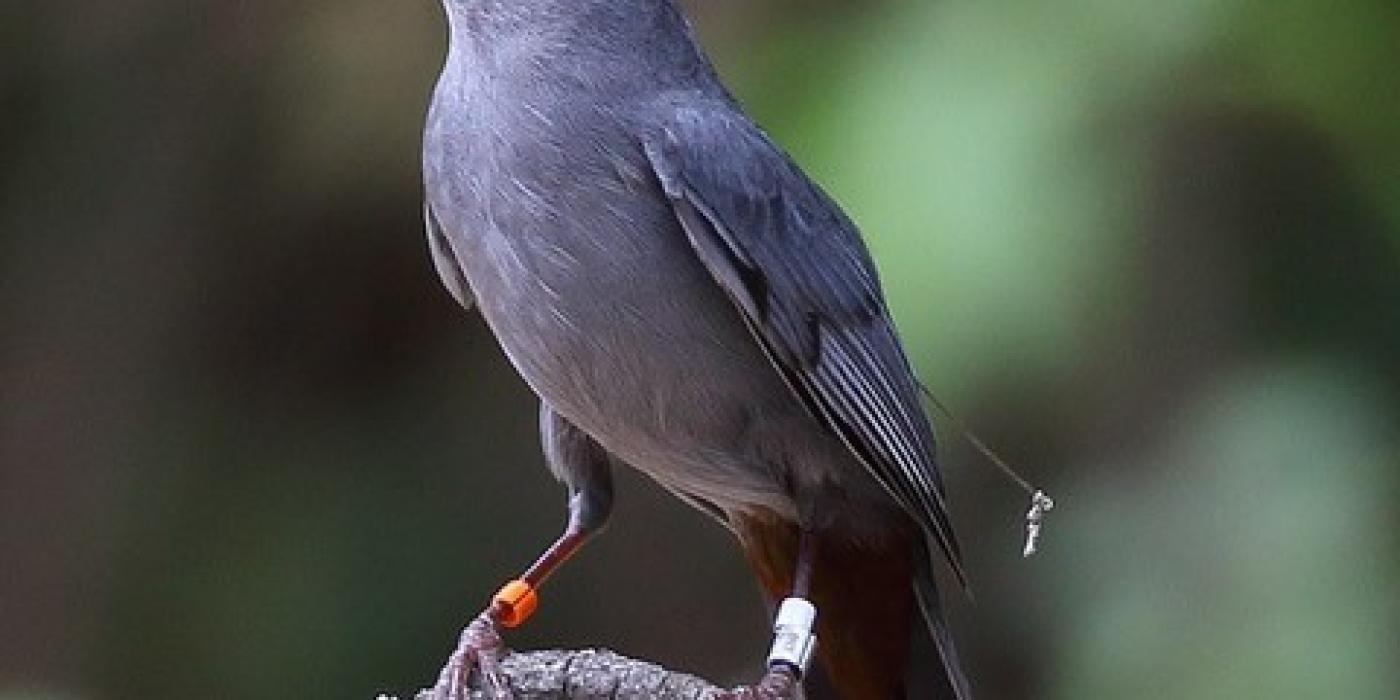Tracking Catbirds with Conservation Technology
Fitted with a GPS device the weight of a paperclip, a gray catbird in the Washington, D.C., area flies south, unaware that the device records its every move. That data is key for conservation biologists, like Brandt Ryder of the Smithsonian Migratory Bird Center, who aim to understand the threats these animals face in a changing world.
Why study catbirds if they are not vulnerable or endangered?
Birds, in general, tend to be fairly adaptable creatures. So, when we see bird populations decline by fifty percent in a relatively short amount of time, it’s imperative that we study the challenges and threats they face. The Migratory Bird Center chose to study catbirds because they face a lot of the same threats that endangered bird species face: climate change, predation by outdoor cats and bird strikes from building and car windows. Unlike birds that live in pristine forests, catbirds are our neighbors; they live in people’s yards and nearby parks.
One of the great mysteries in studying migratory birds is figuring out where they go. Advances in GPS tag technology enable scientists to map their journeys. The tags tell us how long the journey takes, the threats they face along the route and their final destinations. Armed with this information, we are optimistic we can solve the challenging conservation problems facing migratory birds. And, while the catbird is common and might not need that ‘boost’ right now, plenty of other migratory birds do.
"The most exciting thing about this research is that we’re getting information that we never had access to before with some of these birds," says Smithsonian Migratory Bird Center biologist Brandt Ryder. "With GPS tags, we have the unprecedented opportunity to study individual migration routes."
What would people find surprising about catbirds?
Catbirds have a weird social system! The traditional bird social system is defined by territories in which birds defend their territory against other birds of the same species.
Catbirds are different. They’re somewhat typical in that males and females bond and form pairs, but they also tend to be promiscuous and mate with their neighbors. Much of that behavior, however, depends upon the availability of potential mates in the area. The social nature of catbirds means that they are rarely aggressive and are often tolerant of other birds coming and going through their territory.
We’ve studied these social behaviors—along with how the environment influences nesting success—but that was limited to the breeding season (May through September). Until recently, we knew very little about catbirds once they migrate south for the winter.
For this project, we wanted to understand what happens to these birds after they leave their breeding grounds. Are the catbirds that breed here in Washington, D.C. wintering in different areas than those that breed in Massachusetts, Georgia or Colorado? And, what environmental challenges do they face in their wintering grounds?
How do you tag the birds?
With the help of our Neighborhood Nestwatch volunteers, we’ve been tracking birds all over the Washington, D.C. metro area. This citizen scientist program is a really cool opportunity for members of the community to actively participate in bird conservation. We also put tags in three other states where we have Nestwatch hubs. Last summer, we tagged about 100 birds, and we are hoping to tag about 80 birds this summer.
Each tag weighs about one gram—the weight of a paperclip. Catbirds can range in size from 35 to 38 grams. The rule of thumb for GPS tags is that they weigh no more than three percent of the animal’s body mass.
We fit the GPS device on a bird using a device called a Rappole harness made of elastic thread. It’s the same premise as a climbing harness—the loops of the tag fit over each leg, and the tag itself sits on the bird’s lower back. The goal is to use materials that are comfortable for the bird to wear during migration. After a few minutes, the birds will preen their feathers over the tag as though it was never there.
How do you recover the data?
The GPS tags are archival (i.e., stored on the tag), so we must recapture the birds in order to recover the migration and winter location data. As it turns out, once a bird has been caught once, they are very clever, so relocating and recapturing the birds to recover tags can be a real challenge. Normally, we use a passive approach, which means that we put up nets, cross our fingers and hope for good luck. Sometimes the birds are cleverer than we are; they don’t always come back to the same spot. For example, a bird that was caught in a neighborhood may have moved to an area three blocks over. It can take time, patience and a hint of good luck to find them.
When the birds outwit us, sometimes we try to pique their interest in a specific spot. For example, to capture the birds that return to Zoo grounds, our Bird House keepers kindly put out some mealworms for us (no bird can resist a mealworm!). We also go out to sites where we’ve put up nets and use song playback with the hope that the wily catbird is attracted to it and flies into the net. Catbirds also love fruit and high protein foods, so we’ve asked our Neighborhood Nestwatch participants to put out strawberries and suet to attract the birds.
What information have you gathered thus far?
Part of what makes the Migratory Bird Center so successful is that we take risks and employ technology that is cutting edge. We hoped that these devices would give us data from fall and spring migration as well as where the birds spent their winter. The tags worked great for fall migration and identifying winter locations for birds from Washington, D.C., Georgia, Massachusetts and Colorado, but fell short when it came to spring migration because of battery life. The data also provided a snap shot into when birds leave for migration and how long it take a bird to get to from Washington, D.C. to southern Florida or Cuba.
It turns out that some catbirds winter in the Everglades, others in a wildlife refuge along the Gulf Coast of Texas, and so on. These birds are pretty adaptable and use a diverse variety of habitats. What I found most interesting was that once they arrived at their wintering grounds, they didn’t move around very much. That may be because there was a bird feeder or a readily available fruit source. After all, if the birds are finding food, then they don’t need to travel far.
How will this research help catbirds and other migratory species?
The most exciting thing about this research is that we’re getting information that we never had access to before with some of these birds. With GPS tags, we have the unprecedented opportunity to study individual migration routes. This year, we’ve been able to re-tag individuals that gave us data last year. When they return next year, we’ll be able to tell if they winter in the exact same place year after year, take the same route to get there, or migrate at the same pace.
We can then use this data to understand the impact of climate change and the environmental conditions these and other birds face. For example, the factors birds face over winter and during migration can influence how quickly they migrate and how successful they are at reproducing when they arrive. GPS tracking technology (like that described here) provides scientists with an unprecedented look at the way birds live though out the year.
This article was featured in the July 2017 issue of National Zoo News.




